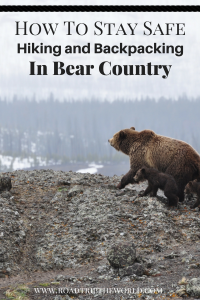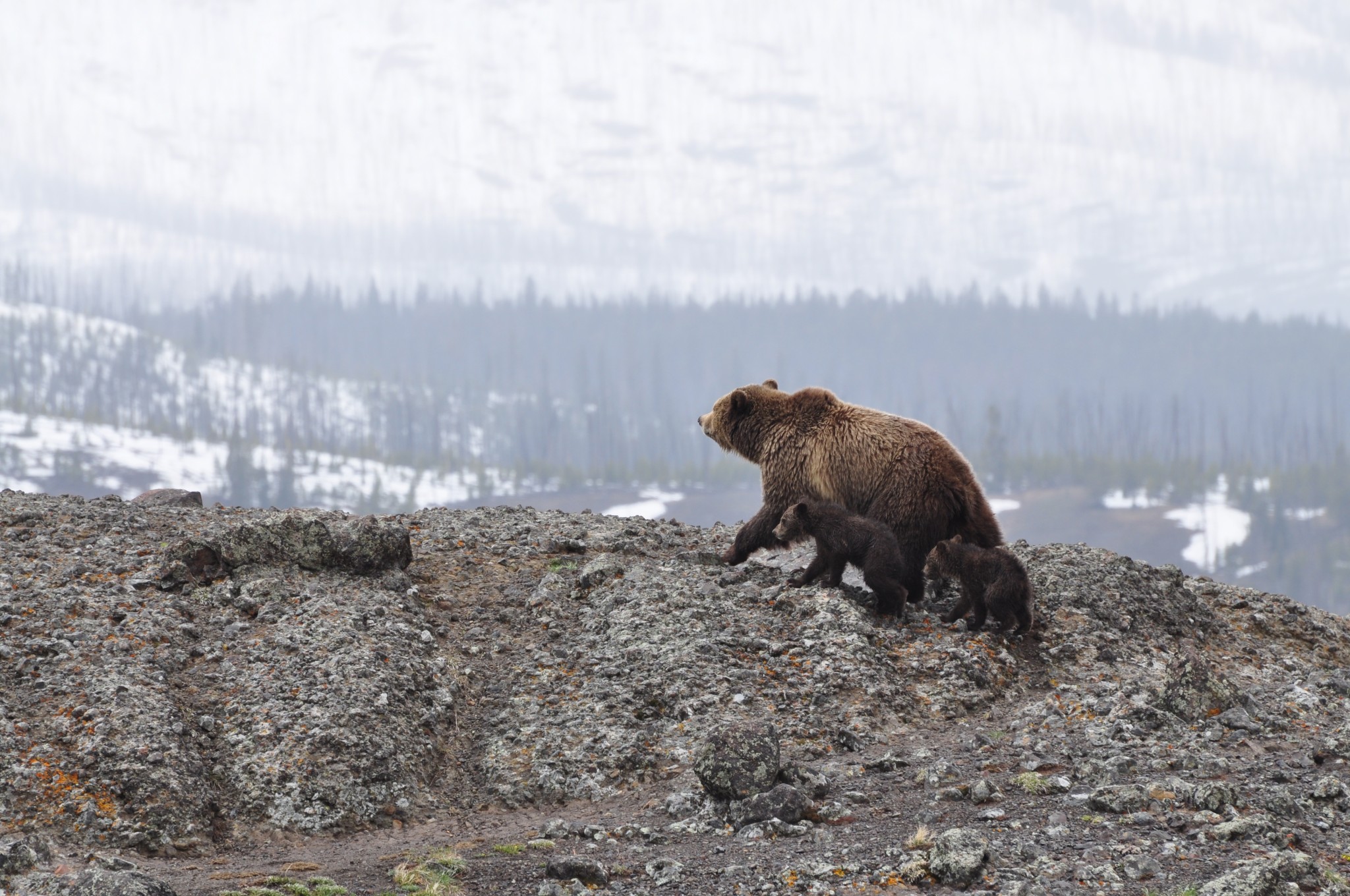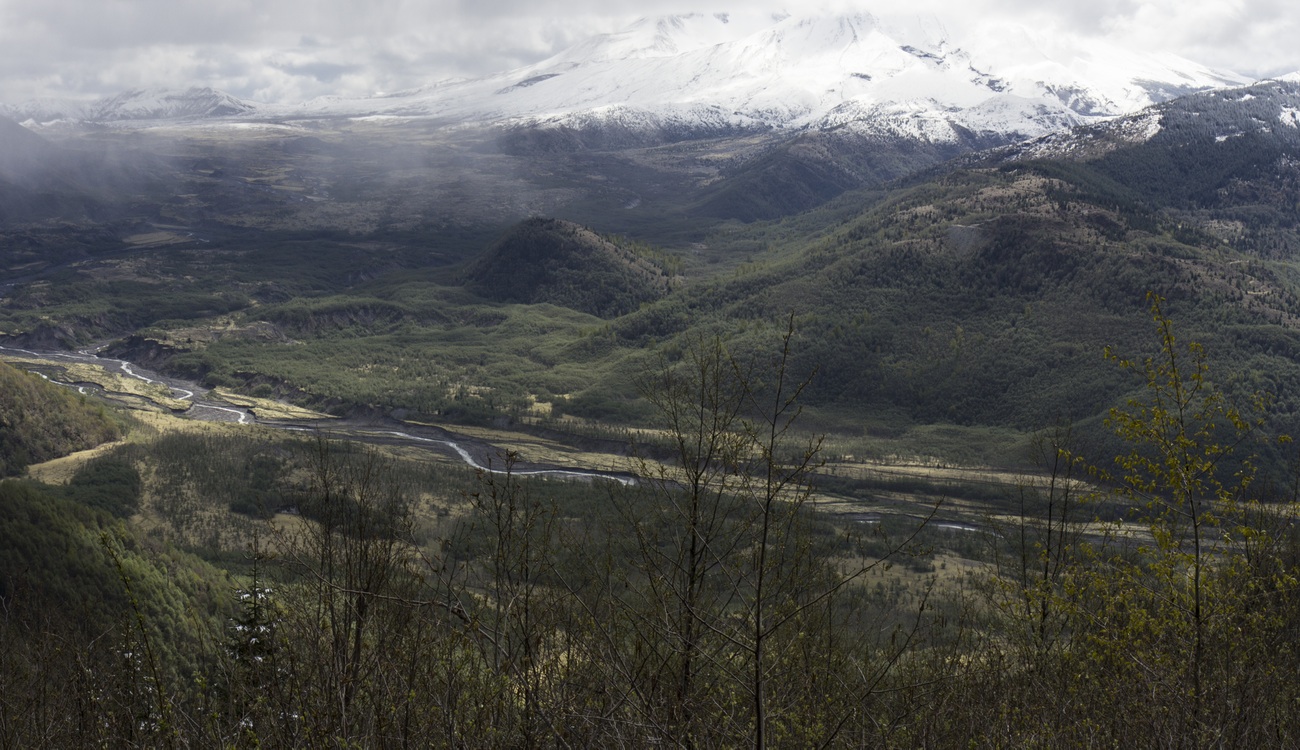One of the things people tell me all of the time is that they are too scared of bears to do any wilderness camping or hiking. Let me reassure you- you are much more likely to be injured while driving to the grocery store or some other common place than you are by a bear encounter. And that’s not going to keep you from shopping, is it? While bear attacks make headlines, it just doesn’t happen that often. That being said, there are actions you can take to stay safe in wilderness areas. Seeing a bear in the wild can be a highlight of any hiking or camping trip, but you should know how to stay safe in bear country before hitting the trail.
The best advice on how to stay safe in bear country is to avoid close encounters in the first place. Pay attention to your surroundings, making yourself aware of bear scat or tracks so that you know they are in the area. Hike with a group because the vast majority of bear attacks have occurred on hikers who were by themselves. Hiking with a group is simply louder, and usually alerts bears to your presence before your group comes dangerously close. When hiking with kids in bear country, I always keep our group close together and the kids nearby. A surprised bear is instantly a more dangerous bear. If you see a bear from a distance, give it room to escape. Turn around and go the other way or make a wide detour to avoid the bear and allow it to maintain a safe distance.
Know the Difference Between Black Bears and Grizzly Bears
To start with, be able to know the difference between bear species that you might encounter. Polar Bears do inhabit parks of Alaska, but in the lower 48, the two types of bears you might see while hiking or backpacking are Black Bears and Grizzly Bears. While attacks on humans have occurred by both species of bears, the manner in which you protect yourself from a bear attack differs depending on whether you are dealing with a black bear or a grizzly bear. There are a few obvious differences between black bears and grizzly bears. Black bears have a straight profile from nose to forehead, where grizzlies have a flattened face from which their nose juts out. The ears on black bears are tall and obvious, while the ears on grizzlies are less prominent. Grizzlies have a shoulder hump, while black bears do not. If guessing what type of bear is in the area based on tracks, the claw markings are further distance apart from the paw pad on grizzly tracks due to the longer claw length. Black bear tracks also show toes that are separated from each other and a prominent arch, while grizzly tracks show toes close together with less of an arch. The following picture from the Center for Wildlife Information, highlights these differences between bear species.

Picture From the Center For Wildlife Information Website
How to Stay Safe in Bear Country – Black Bears
The most common species of bear in the U.S. is the Black Bear, or Ursus americanus. Black bears can be found in forested regions throughout the United States and are known to inhabit 40 states. While their name implies that their fur is black, black bears can actually be brown, gray and many other variations of color. I have seen both black and cinnamon colored black bears in the wild. According to National Geographic, black bears vary in size from 5-6 feet long and 200-600 pounds in size.
Omnivores, black bears in the wild subsist mainly on roots, nuts, berries, insects, fish and small mammals. Black bears have been know to feed on carrion and also will hunt and feed on larger mammals if the opportunity presents itself, including young deer, moose and elk. While predatory attacks on humans by black bears are rare, they have occasionally occurred. There have been 13 fatal black bear attacks in North America in the last ten years, according to Wikipedia. Exposed to human food often enough, they will attempt to pillage campsites and food sacks in order to get a meal which puts them in dangerous proximity to hikers and backpackers.
Black bears are fast runners and scale trees with ease. While they have good eyesight and hearing, their sense of smell is unmatched. Generally, black bears will shy away from human contact and many times the first sign of a black bear in the area you will see on the trail is their rump as they flee into the woods. However, there are times when black bears will act aggressive towards humans, either as a fight response when intimidated, or worse, when it has determined that the human is their prey.
If you encounter a black bear in the wild and it hasn’t run off, grab your Bear Deterrent Pepper Spray, remove the safety and talk slowly and calmly to it while slowly backing away from the bear. Do not under any circumstances run away from the bear or turn your back on it. Just do your best to remain calm and back away from it. It will usually run off. If that doesn’t work, keep your group together and stand tall and confidently yell at the bear to scare it off. If the bear is still undeterred, maintain eye contact with it while forcefully telling it to go away and prepare to use the Bear Spray if it moves into your space. If the bear gets within 10-20 yards or starts to charge, aim slightly downward and release a cloud of pepper spray between you and the bear. Keep spraying until the bear is stopped and then leave the area immediately.
As you can see, it is important to always have your Bear Deterrent Pepper Spray within reach when hiking in bear country. Some would say that bear spray is overkill when hiking in black bear country, but since I am typically hiking with my kids, I disagree. The small amount of weight of bear spray is more than worth it to me to know I can better keep us safe. Trust me when I say it helps to know that you have the best bear spray to hand should you ever need it. I keep mine in the provided holster and hang it on the side of my pack. Bear spray isn’t helpful if it is stuffed in your pack outside of reach. In the very rare circumstance that the black bear is undeterred by the pepper spray and is attacking you, fight for your life with whatever weapon is available.
How to Stay Safe in Bear Country – Grizzly Bears
Grizzly bears live throughout Western Canada, Alaska, Wyoming, Montana and Idaho. According to Defenders of Wildlife, there are about 1,800 Grizzly Bears or Ursos Arctos in the lower 48 states. Like black bears, grizzly bears also have color variations, but typically have brown fur. According to National Geographic, grizzly bears are between 5-8 feet long and can weigh up to 800 pounds.
Also like black bears, grizzlies are omnivores and much of their diet consists of berries, nuts, fruit, insects along with fish and mammals of all sizes. Grizzlies also usually avoid humans, but when cornered they are much more likely to attack than black bears, especially if it is a mother with cubs or if it is protecting a kill nearby. There have been 15 grizzly bear fatalities in the last 10 years according to Wikipedia. Grizzly bears are amazingly fast considering their large size, and also are able to climb trees.
If you encounter a grizzly bear on the trail, it is important to remain calm. If the bear hasn’t seen you, back away and detour around it. Never approach a grizzly bear. If the bear has seen you and is approaching you, remain calm as best you can and slowly take hold of your Bear Deterrent Pepper Spray while you back away. It is important to teach everyone you are hiking with to never run away from any bear as this triggers a chase response.
According to the Yellowstone National Park website, if the grizzly bear acts aggressively and starts to charge, stand still and try to remain calm. If the bear gets within 10-20 yards or starts to charge, aim slightly downward and release a cloud of pepper spray between you and the bear. Many times, the bear is making a bluff charge and will leave when the bear spray is released. If this is not the case and the bear makes contact, drop to the ground and play dead. Keep your pack on to protect your back and lie on your stomach while protecting your neck and face with your arms. Stay as still and silent as possible to let the bear know you are not a threat. Stay quiet and still until you know the bear is gone and then leave the area. Sometimes bears behave in a predatory manor. Different from a defensive attack, a predatory bear will calmly approach in a curious manner, not huffing or acting agitated. If this is the case, use Bear Deterrent Pepper Spray and fight for your life with whatever weapons you have as aggressively as possible. For more information, click HERE for an educational video from Glacier National Park about how to stay safe in bear country.
In grizzly bear country, you should ALWAYS carry bear spray and you should keep it readily accessible. According to studies conducted by U.S. Fish and Wildlife Service, bear spray is more effective in preventing injury during a bear encounter than guns. Study results showed that people who defended themselves from a bear attack with bear spray escaped injury the majority of the time and those that were injured experienced “shorter duration attacks and and less severe injuries.” Seems like a no brainer to me. Just carry bear spray. 

How to Stay Safe in Bear Country – Keep a Clean Camp
Keep a clean camp so that bears won’t visit while searching for food. Cook and eat away from the area you will be setting up camp. In grizzly bear country and in areas known to be frequented by bears, I like to stop for a dinner break late in the afternoon and then hike on so that no cooking is done where we are sleeping and we avoid cooking foods with strong odors such as fresh bacon or sausage. All food, garbage, and toiletries should be stored where bears can’t get them. If available, use the bear proof storage locker at your campsite to store your food, garbage and toiletries. Some backcountry sites have bear cables or bear poles in place for safe food hanging. Certain areas of the country, including Yosemite, Sequoia and Kings Canyon National Parks require the use of a Bear Canister to store food when hiking in the backcountry. Otherwise, always carry at least 100 feet of rope in order to hang your food bag from nearby trees making sure it is suspended at least 10 feet off the ground and 4 feet from either tree. One of the most important lessons on how to stay safe in bear country is to NEVER eat in your tent when hiking in bear country and keep your bear spray close to you at night when going to sleep.
How to Stay Safe in Bear Country – Knowledge is Power
Bear attacks are incredibly uncommon, but you should know how to stay safe in bear country before heading out for a hike where bears inhabit. Doing what you can to avoid bear encounters in the first place as well as knowing how to react when an encounter does occur significantly increases your level of safety when hiking in bear country.
Check out these additional resources about how to stay safe in bear country –
Backcountry Bear Basics by Dave Smith
Backpacker Magazine’s Bear Country Behavior: Essential Skills And Safety Tips For Hikers by Bill Schneider
NOLS Bear Essentials: Hiking and Camping in Bear Country by John Gookin
Have you ever had a bear encounter when out on the trail? I’d love to hear about it!
Happy Trails!







Last summer my 14 year old daughter and I, along with our friends (another lady and her 14 year old daughter) did a 2 night hike in the Canadian Rockies near Kananaskis. The hike in was rather uneventful in regards to wildlife and we got set up in camp quite late. We were all pretty tired so we went to bed soon after we got set up. Through the night I was woke twice by a bear doddling and sniffing past our camp. It took its time passing but never came right in. It stayed about 10 feet out on a trail. The next day we got up and discovered it had made a midnight snack of bugs from an old stump it had ripped up from the ground. It was very exciting but I can say I slept very lightly the rest of the trip. That situation always makes me nervous because a tent is not a place you want to spray bear spray if they decide to come check it out.
My sisters, some friends and I just did 75 miles of wilderness backpacking in Washington. As soon as we got to our first camp we saw a yearling cub waltz through as if he was just saying hi. It was such a relief that we had done our bear safety reading before our trip! We did everything we were supposed to but that bear must have had many free handouts from previous campers because it sniffed around our camp and hung out for hours while we were shaking in our tents–bear spray and gun in hand! None of our group of 6 got much sleep that night. There was a couple there with their food in paper bags. I think our warnings to them thwarted a bear attack due to improper food storage. Luckily they were the kind with handles and it wasn’t raining so the were able to use the bear pole. Later we saw a mother and 2 cubs on the trail. We just backed up slowly and kept talking. They went about their business. Later that same day we heard a bear huffing as we walked near by. We couldn’t see it and just kept being loud and kept our pace. 3 pretty significant encounters and none of the bears gave us any trouble. It was such an amazing experience all around!
Sounds like you had the very best kind of bear scenarios! While I LOVE seeing bears in the wild, it definitely gets my heart beating fast when I do!
Back in the early nineties when I was a helitack firefighter in California I would spend some of my days off hiking and exploring some of the areas around a fire lookout my brother worked at in the Mendocino NF. Black bears are prevalent on the Mendocino so seeing one or two wasn’t a supersize until while on a hike I stopped to rest under a Jeffery pine when a black bear with a blonde nose came rambling down the same trail I was just on. Sniffing the air and bobbing its head up and down and side to side tasting my sent in the air. I sat in silent watching as the bear past by. After about 15 minutes I decided to leave only to notice the same bear had circled around and behind me. As I stood up making myself look big the bear huffed and turned and bolted in the opposite direction leaving a short trail of bear scat in its wake. I’ll never forget that experience.
Connor- That is a wild story! And I am pretty sure I would have left my own trail of scat in that situation. Haha!
Great tips! More people definitely need to be aware. I RV full-time and I have seen so many people make ridiculous mistakes, then it costs the bears their lives all because someone left their Doritos outside 🙁
Michelle, you are so right! It is horrible to realize that animals must die because of our own stupidity. BTW, I am loving reading about your life in an RV! Happy travels!